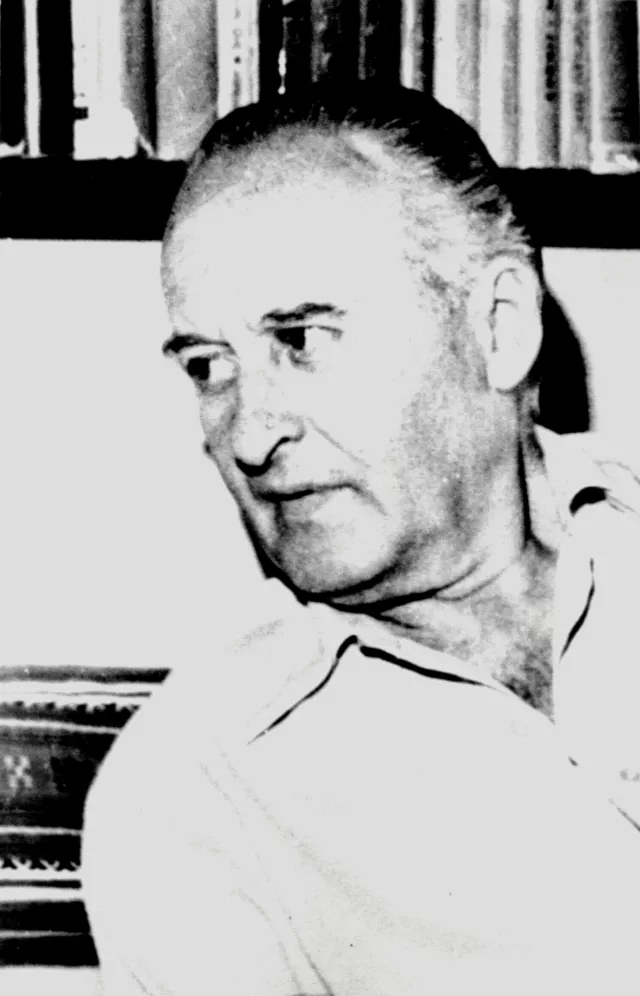This photo was taken in 1979 in the study room of our apartment on Jokai Street. I don't remember who took it, probably one of our family friends. In 1979 I had already been working for decades at the history of medicine chair of the university in Kolozsvar as researcher and university professor.
I abandoned my career as medical practitioner and dedicated myself to the history of medicine. I hadn't given up practice entirely, but I restricted it to my family. I studied the history of medicine in both Transylvania and the Regat. I wrote and published several books in Romanian, in which I presented the history of medicine and its greatest personalities in the Hungarian community of Transylvania. I published them in Romanian because I wanted to familiarize the Romanian public with this slice of culture of the Hungarians from Transylvania. My first step, in which my mentor, Professor Valeriu Lucian Bologa, was of great help, was to get acquainted one step at a time with the subject, the Romanian and Transylvanian, respectively the European medical traditions and their historical development. I had to get familiar with the medical procedures and the domestic medicine, as well. In time I managed to get into the scientific work of the different authors on the history of medicine in Romania. I paid special attention to the impact of European medicine on Transylvania and Romania. It was a necessary thing to do, and after I did it I was able to organize my thoughts, my sources grew in number and I began writing down what I had learnt. I began working at the chair in 1945, but my first book only came out in 1954. By then I knew and processed many works, and those were the basis for my book, a collection published in 1954 by the Romanian Academy.
As my knowledge developed, I advanced within the university from trainee to lecturer, and then to the assistant professor position. When my professor couldn't be present for various reasons, say when he was away or ill, I was holding the lectures and seminars. A long year had to pass until I acquired enough knowledge to publish, along with and assisted by my professor, more comprehensive, synthetic works. In 1955 we published our work on the history of domestic medicine, for which in 1957 both Professor Bologa and myself received a National Award.
Besides the history of medicine I also studied the history of pharmacy. I have an accomplishment in this field I have to mention. In the 1950s, that is, after the nationalization of the drug stores, I created a Museum for History of Pharmacy in the Hintz drug store here in Kolozsvar. Of course, I used to its full value the famous history of pharmacy collection by Gyula Orient from Kolozsvar. To these I added the values in the field of history of pharmacy I gathered from the nationalized drug stores. There were beautiful pharmaceutical equipment, paintings, and a beautiful baroque-style office desk. I see this museum as the greatest achievement in my life because I enriched the cultural life of Kolozsvar.
After my professor retired in 1962, I took over the lectures. For Professor Bologa, his office at the chair was kept for him right until his death, and he was always there, working. It was very important for me to provide him a place where he could work in peace. It never crossed my mind to move into his office; the more so since I had my own office.
In 1979 I wrote a study on the history of pharmacy of four hundred pages. This was a universal history of pharmacy, with special focus on the development of the domestic, that is the Romanian pharmacy. No other such study has been published since. There are some very valuable works related to the history of the domestic Romanian medicine and pharmacy, but that book remains the only one related to the universal history of pharmacy ever written in Romanian.
Samuel Izsak
The Centropa Collection at USHMM
The Centropa archive has been acquired by the United States Holocaust Memorial Museum in Washington, DC.
USHMM will soon offer a Special Collections page for Centropa.
Academics please note: USHMM can provide you with original language word-for-word transcripts and high resolution photographs. All publications should be credited: "From the Centropa Collection at the United States Memorial Museum in Washington, DC". Please contact collection [at] centropa.org.












